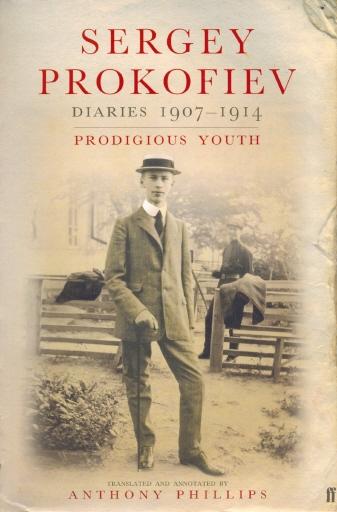
When contacting us by e-mail, correspondents are asked to include their name and full postal address and, when providing information, to quote exact book and magazine sources. The word ‘chess’ needs to appear in the subject-line or in the message itself.
| First column | << previous | Archives [33] | next >> | Current column |
An extract from the entry dated 7 April 1914 (old style calendar) in S. Prokofiev’s diary, regarding the St Petersburg tournament:
‘At eight o’clock I went to the opening of the Chess Championship and found myself translated immediately into an enchanted realm, a realm alive with the most unbelievable activity in all three rooms of the Chess Club itself and three more rooms made available by the Assembly Committee. This tournament is a top-level affair, everyone in tailcoats, and here were the masters themselves each surrounded by a crowd of admirers.
Lasker, a little greyer since the 1909 tournament, with his distinctive face, his slight stature and an air of knowing his own worth; Tarrasch – a typically upright German with Kaiser Wilhelm moustaches and an arrogant expression; our own Rubinstein – a coarse, unintelligent-looking face, a touch of the shopkeeper about him, but modest and talented compared to Tarrasch, erratic but dangerous to any opponent; Bernstein, a prosperous-looking man with a handsome, impudent face, shaven head and a colossal nose, dazzling teeth and relentlessly brilliant eyes. Our own gifted Alekhine, with his lawyer’s coat and his slightly pinched, slightly disagreeable lawyer’s features, self-confident as ever but nevertheless a little subdued by the magnificence of the company. Marshall, the American, a typical Yankee, with a touch of Sherlock Holmes about him, ferociously passionate in play but ludicrously taciturn in private. Yanovsky [sic] from Paris, a deserter in his youth from military service and now exceptionally allowed special dispensation to return unmolested for the championship, wearing an exquisitely elegant light grey suit, formerly a famously good-looking breaker of hearts but now in his fifth decade showing his age and wearing gold-rimmed spectacles. The combative vegetarian Nimzowitsch, a typical German student and trouble-maker. Finally two older men, destined to be the victims of all, the portly Gunsberg and, wearing on his face a permanently injured expression, Blackburne, still, despite his 72 years, capable of producing original combinations and elegant developments in his conduct of a match. The crowd’s favourite, Capablanca, young, elegant, gay and with a constant smile on his handsome face, circulated through the hall laughing and chatting with the easy grace of one who already knows himself to be the victor.
Thus it was that I found myself in this irresistibly seductive kingdom, absorbed from the first moment by the forthcoming contest. The speeches began, laying stress on the unprecedented importance of the event with its exceptional galaxy of participants. Journalists from England, Germany, Moscow, Kiev, Vienna, chess masters from Germany, photographers, all added to the splendour of the occasion. The first round begins tomorrow!!!’
Source: pages 640-641 of Sergey Prokofiev Diaries 1907-1914 translated and annotated by Anthony Phillips (London, 2006).

Prokofiev’s reference to photographers is the diary entry quoted in C.N. 4925 prompts a question: have many photographs taken during the St Petersburg, 1914 tournament been published?
Few come to mind. There are, of course, the very famous ‘first five grandmasters’ shot and the group picture; see pages 65 and 76 of A Picture History of Chess by Fred Wilson (New York, 1981). Page 87 of that book has a picture taken during the first game at St Petersburg between Capablanca and Lasker. In Chess Explorations we gave a large, less well-known group photograph, which was an insert (Beilage) to the 31 May 1914 issue of Deutsches Wochenschach:
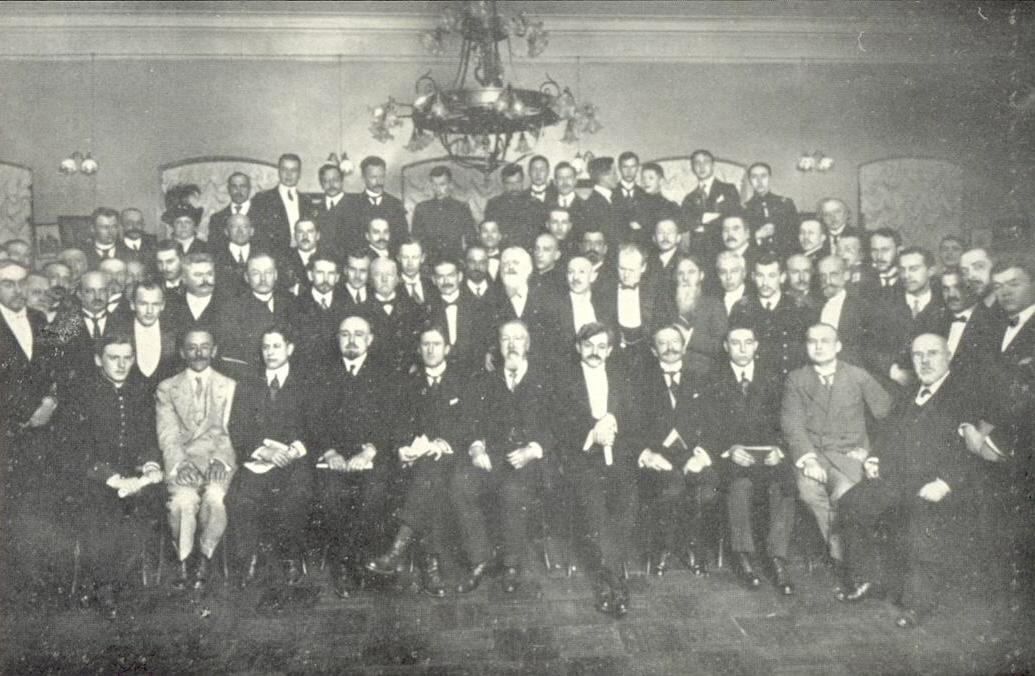
Has a key to this photograph ever appeared?
Sergey Prokofiev Diaries 1907-1914 contains a rather poor version of the better-known group photograph, which page x incorrectly describes as depicting ‘The 1914 St Petersburg World Chess Championship’.
The index to Sergey Prokofiev Diaries 1907-1914 has, on page 819, over 70 references to chess, and the index entry for Capablanca (pages 802-803) is ten lines long, with 16 references. On page 582 (diary, 8 January 1914) Prokofiev writes:
‘Around six o’clock Capablanca came into the Club: he is an utterly irresistible person, lively, handsome, quick-witted, and – this is the point – a genius. You should have seen how quickly he showed up the mistakes of our Petersburg masters: on the spot, the instant their games were finished, and right in front of their very eyes! I was entranced.’
As noted on pages 80-81 of our book on Capablanca, the Cuban gave three simultaneous exhibitions in St Petersburg at which Prokofiev took a board. Capablanca won the first two games and lost the third. We believe that only the third game-score is currently known, but Prokofiev’s diary entry for 15 May 1914 (page 681) gives an extensive account of his second game. He mentions that it began 1 d4 d5 2 Nf3 Bf5 3 c4 Nc6, after which Capablanca (White) ...
‘... stood in front of the board for two or three minutes frowning and pulling at his hair. I was thrilled beyond words at having set the champion a real problem ...’
Also on page 80 of our Capablanca book a 20-move simultaneous game ‘Capablanca v Bashtirov’, St Petersburg, 1914 was given, from page 103 of Capablanca-Magazine, 31 July 1914. However, the Diaries contain so many references to Boris Nikolayevich Bashkirov (a ‘wealthy amateur poet’ whose pseudonym was Boris Verin) that it now seems to us almost certain that ‘Bashtirov’ is incorrect. Chess-related references to Bashkirov appear on pages 682-683 and 741 of the Diaries. The latter, which is in an entry dated 21 September 1914, states:
‘While we talked he [Bashkirov] told me many interesting things, among them about a certain Mme Strakhovich, to whom he had introduced Capablanca who had fallen in love with her; it was due to her that he had failed to capture the first prize.’
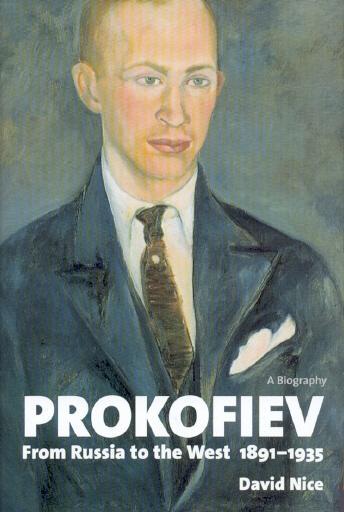
Chess also features extensively in Prokofiev From Russia to the West 1891-1935 by David Nice (New Haven and London, 2003). The plates section has a photograph of Prokofiev ‘playing chess with former neighbour Morolev at Nikopol, 1909’. From page 292 (concerning the early 1930s):
‘There was a good chess companion in Mischa Elman, though it would have been better still to have had the company of Capablanca, whose participation in the Paris congress he had been following with interest – “congratulations for the games you won, but you’re too lazy and you must win more.” [Page 354 states that this comes from a letter from Prokofiev to Capablanca dated 26 July 1931.] Capablanca duly obliged by losing not a single match.’
For ‘Paris congress’ read, presumably, ‘match with Euwe in the
Netherlands’, although that contest had ended on 10 July 1931.
Pages 311-312 of the biography have the following information regarding Prokofiev in 1933:
‘As for chess, which he was still enjoying regularly at Napoleon’s old haunt of the Café de la Régence, he played two games with the famous Saviely Tartakower, winning the first and drawing the second. There seemed no reason why he should not exploit his triumph for publicity purposes in America. “Tartakower is one of the strongest players in the world”, he told Gottlieb in an extended version of the news he had already passed on to Haensel, “and has the title of ‘Grossmeister’ – so you can imagine how proud I was to win. When, after the game was over, I asked Tartakower to show me what mistake he made to lose it, he answered: ‘I made no mistake; simply you played well’.”’
We add that Tartakower annotated the finish on pages 426-427 of L’Echiquier, 17 February 1934:
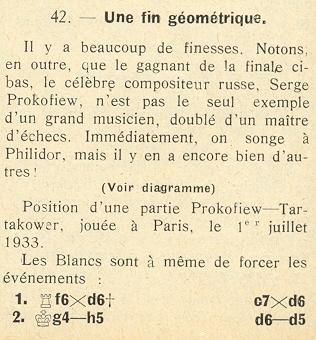
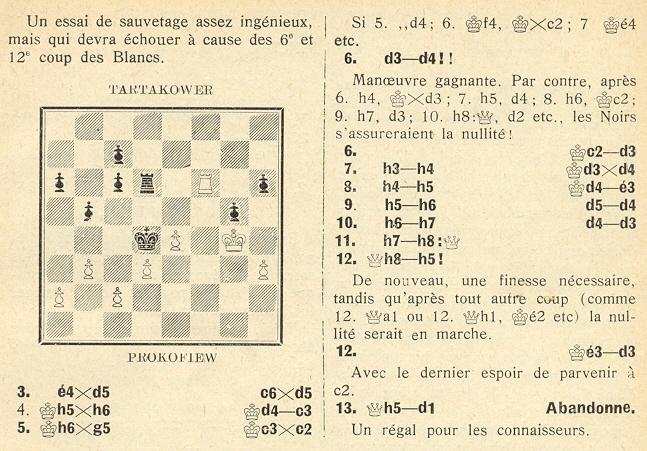
It may be recalled that Tartakower included a victory over Prokofiev (Paris, February 1934) on pages 46-47 of his second volume of Best Games.
Michael Lorenz (Vienna) draws attention to the reference to Réti’s marriage on page 189 of Richard Réti šachový myslitel by Jan Kalendovský (Prague, 1989). Her maiden name was Rogneda Sergeievna Gorodetskaia, and she was the daughter of the Russian poet Sergei Gorodetsky (1884-1967). The couple met during the Moscow, 1925 tournament and married in Moscow on 28 May the following year (Réti’s 37th birthday). A footnote in the Czech book stated that in 1987 she was still alive, in Moscow.
A future item will discuss the material about Réti’s wife, which includes two photographs, on pages 29-33 of the Russian-language work Richard Réti by Anatoly Matsukevich (Moscow, 2005).

Richard Réti
4930. A. Rothman
In C.N. 413 (see page 107 of Chess Explorations) W.H. Cozens quoted the following passage from page 51 of Chess Memoirs by Joseph Platz (Coraopolis, 1979):
‘My opponent in the next two games [A. Rothman] was considered to be a specialist on opening play. I was present when Reuben Fine asked him: “Is it true that you know all columns of MCO by heart?” And he answered: “Yes, it is true.”’
What biographical details are available about Rothman?
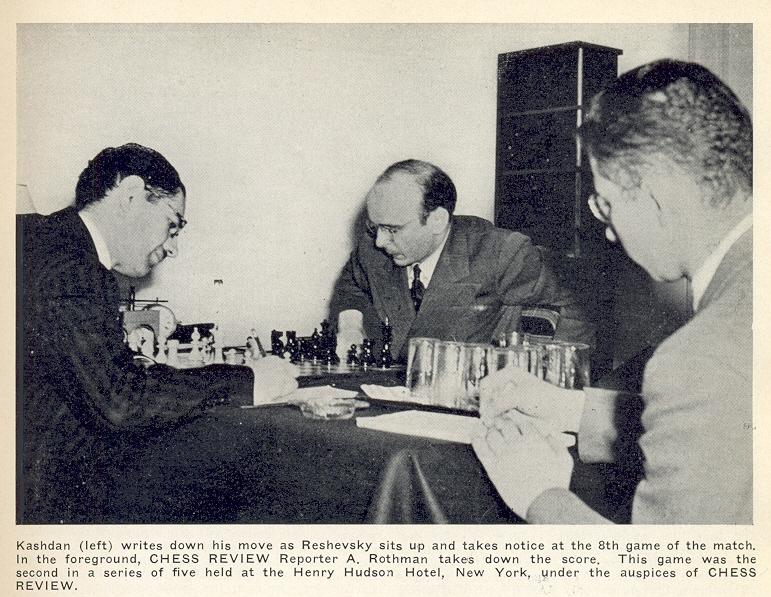
Chess Review, January 1943, page 3

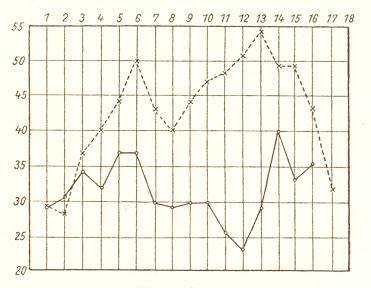
C.N. 4901 asked about the connection between the above two illustrations.
The chart, from page 130 of the May 1935 Deutsche Schachzeitung, depicts Paul Morphy’s 17-move miniature against the Duke and Count in terms of the units’ mobility after each move.

Which is the rarest monograph on Paul Morphy? Our suggestion is La odisea de Pablo Morphy en La Habana by Andrés Clemente Vázquez (Havana, 1893).
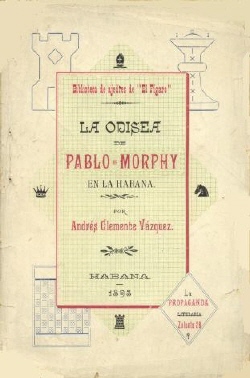
A booklet of under 60 pages, it mainly comprises quotes from the local press, and the few games given all found their way into later volumes on Morphy. The one illustration, on page 27, has the caption ‘“Soirée” de jugadores de ajedrez, en casa del Sr. D. Francisco Fésser (Habana), el 17 de Octubre de 1862’, with players identified as ‘A. Medina, Mr Paul Morphy, F. Fésser, F. Sicre, B. Dubouchet, G. Toscano’.
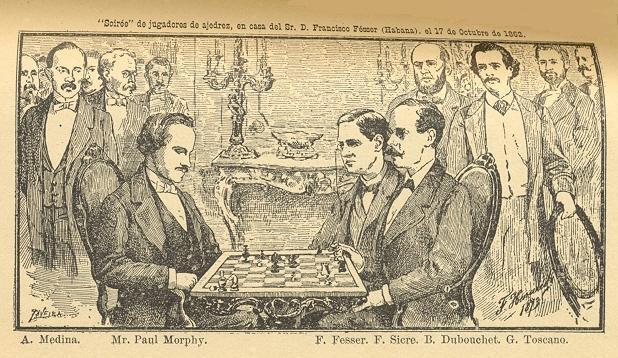
See also page 271 of David Lawson’s Paul Morphy The Pride and Sorrow of Chess (New York, 1976). We should like to find out more about Félix Sicre, who had been regarded as the Cuban chess champion.
We present a list of Morphy books (excluding reprints) in our
collection which have been published since David Lawson’s
biography in 1976.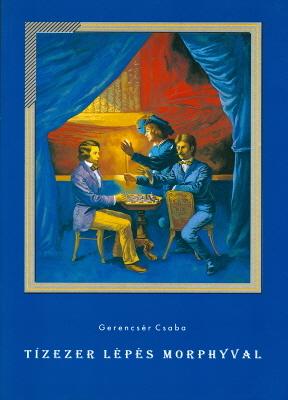
C.N. 4809 referred to the 10-11/1967 number of the Cuban magazine Jaque Mate, which was in large part devoted to Che Guevara. It had no fewer than 26 photographs of him, but most were of poor quality. Joost van Winsen (Silvolde, the Netherlands) draws attention to a webpage with a selection of photographs of Che Guevara and another with a very brief video sequence of him playing chess.
The group photograph of Nottingham, 1936 is one of the most frequently reproduced illustrations in chess history. Another picture taken during the event (Lasker playing golf) was given in C.N. 3474, and below are some more, beginning with Alekhine in the first round (his lapsus manus opening against Flohr):
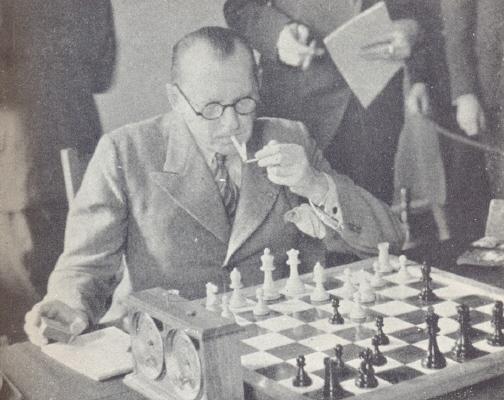
That picture is relatively well known, having been published, for instance, on page 16 of Chess Review, April 1946 and in The Treasury of Chess Lore by Fred Reinfeld (New York, 1951). A photograph of Alekhine in play against Euwe was given on page 229 of the October 1936 Chess Review.
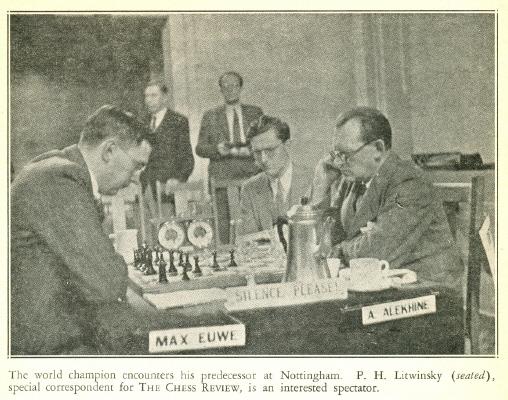
P.H. Litwinsky was later known as Paul Hugo Little.
Another photograph of the playing hall comes from page 201 of the September 1936 Chess Review:
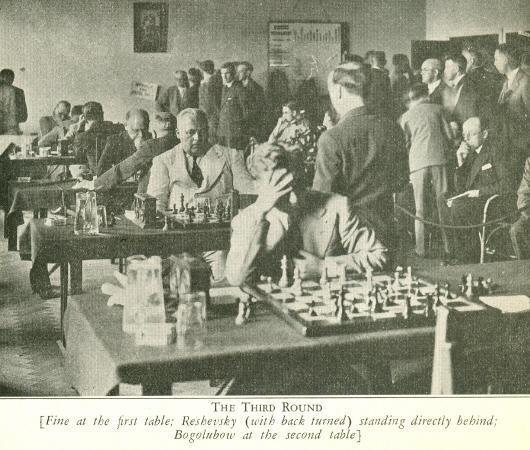
Savielly Tartakower and Sir George Thomas were featured on page 20 of CHESS, 14 September 1936:
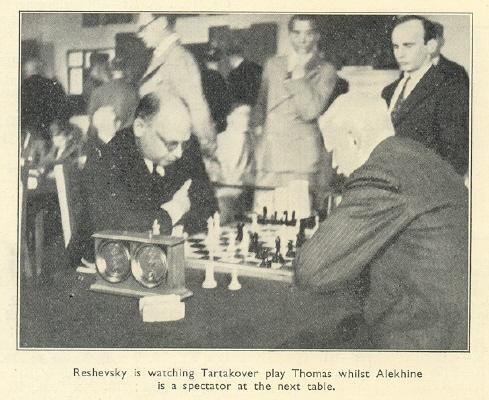
Botvinnik, in play against Alexander, was shown on page 2 of the same issue:
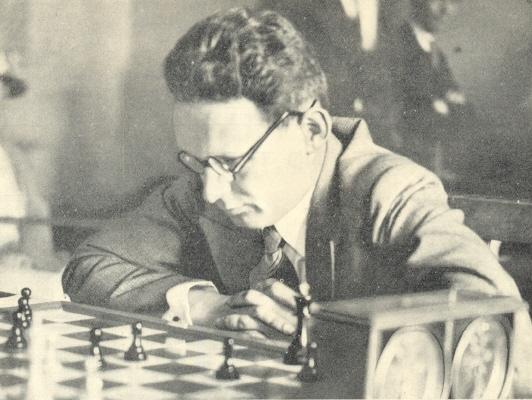
A further picture is currently available to us only in a poor-quality version from a scrapbook (Capablanca v Bogoljubow):

After Capablanca died, page 98 of the April 1942 CHESS printed a photograph of Capablanca in Nottingham with H.G.T. Matchett:
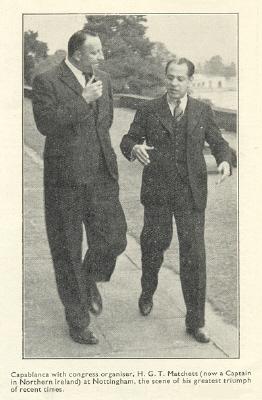
Four outdoor photographs of the masters were published in the Chess Review, September 1936 (pages 200, 203, 204 and 211):

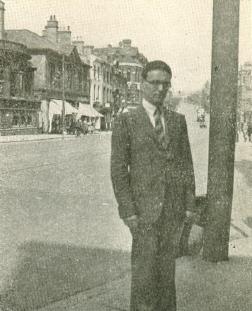
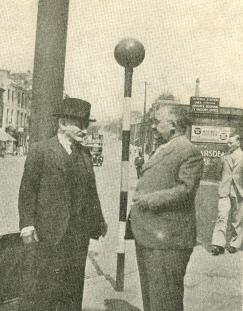
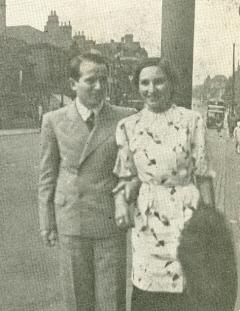
Left to right: José Raúl Capablanca, Mikhail Botvinnik, Emanuel Lasker and Milan Vidmar, Salo Flohr and his wife.
Page 7 of CHESS, 14 September 1936 had a picture of the wives of Euwe, Botvinnik and Flohr:
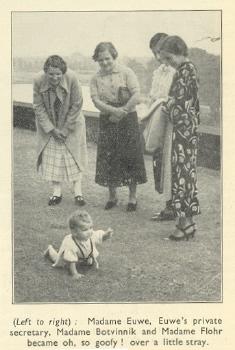
Finally, the following group shot appeared opposite page 481 of the October 1936 BCM:
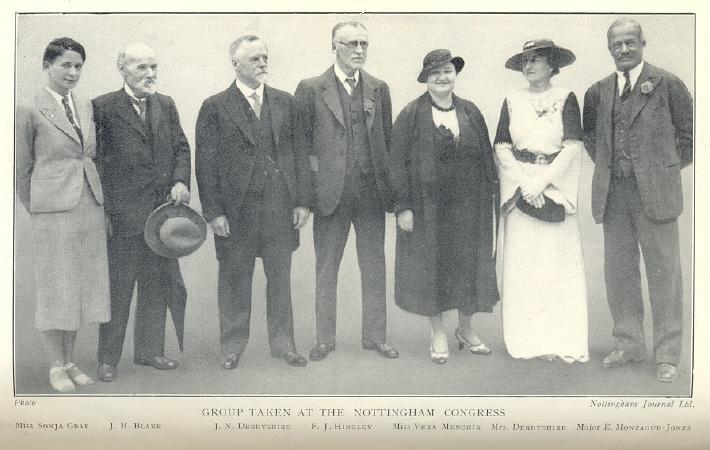
Did any local newspapers of the time have further photographs?
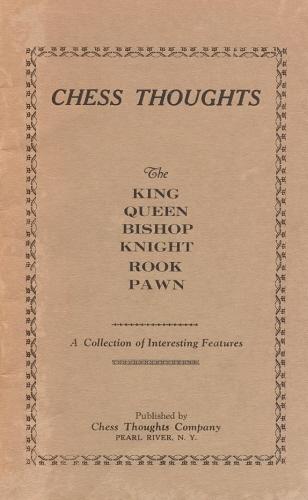
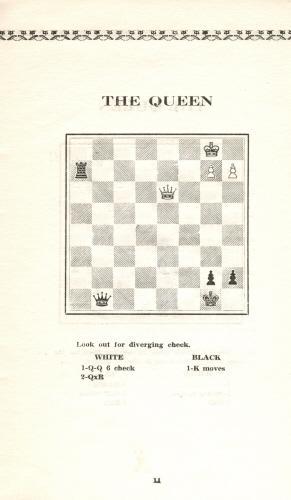
This scarce anonymous booklet Chess Thoughts was published by Chess Thoughts Company, Pearl River, NY (in the late 1930s, according to the catalogue of the Cleveland chess library). Page 11 above is quite typical, and we wonder how long, to the nearest second, it took to write.
It provides a rare example of the term ‘diverging check’, in the sense of ‘fork’. See page 138 of Chess Facts and Fables for ‘divergent check’ and ‘check divergent’ (used in the 1840s with the same meaning).
Awani Kumar (Kanpur, India) reports that he has found four diagonally magic tours on a 12x12 board. Readers are referred to his articles in issues 26 and 43 of the Games and Puzzles Journal. It will be noted that further papers by our correspondent appeared in issues 22, 24, 32, 42 and 43 of the Journal.
The sketch in C.N. 4921 was of Sergei Belavenets (1910-42), being the frontispiece to the monograph on his career (Moscow, 1963).
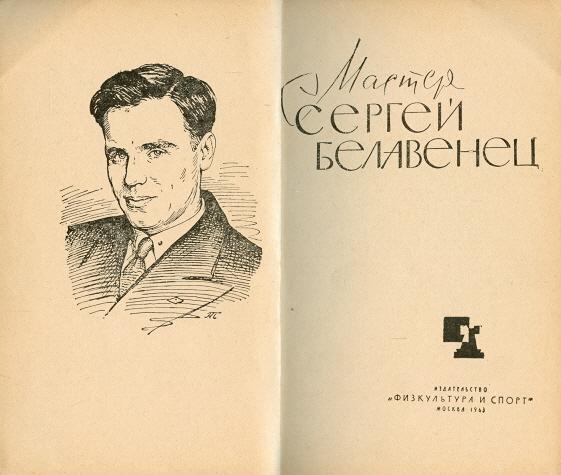
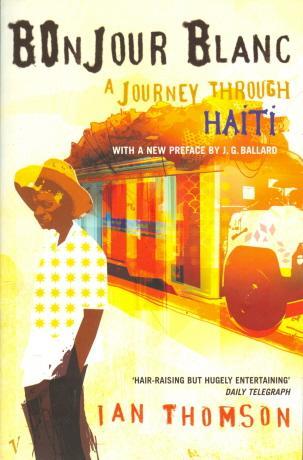
Bonjour Blanc by Ian Thomson (London, 2004, but originally published in 1992) is subtitled ‘A Journey through Haiti’, and the publicity material states that ‘a Swiss chess champion’ was one of the ‘lively gallery of eccentrics’ encountered by the author. He is named as Gottfried Kraüchi, and a brief sample passage from page 70 is reproduced below:
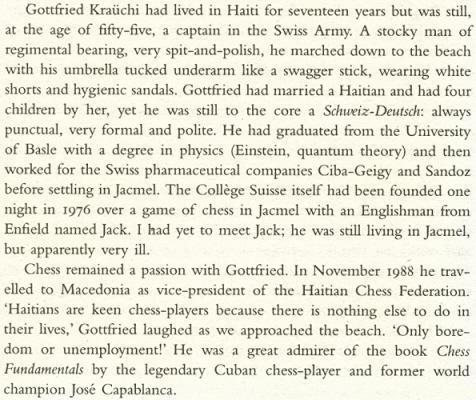
For Kraüchi read Kräuchi. The term ‘a Schweiz-Deutsch’ is
peculiar, and we can vouch for none of the other information,
except that he was indeed listed as the Haitian delegate on page v
of FIDE’s minutes of the 1988 Congress in Thessaloniki. His name
appeared there as ‘Gottfied, Krauchi’ (sic).
Gordon Cadden (Newport, Wales) refers to an editorial on pages 1-2 of the January 1946 BCM (Editor: J. du Mont) which advised against rushing to judgement over Alekhine’s war record. After quoting the ‘parallel cases’ of alleged collaboration by Georges Carpentier and Maurice Chevalier (‘both men were tried and found not guilty, and both are again the idols of the French public’) the editorial stated:
‘We ourselves have received letters describing how Eliskases, in German uniform, strutted into Belgian chess clubs and how the Belgian players, at the risk of their lives, declined to play him. As our readers know, Eliskases has been in South America for the past six years. So much for “evidence”.’
Is anything else known about the accusations against Eliskases?
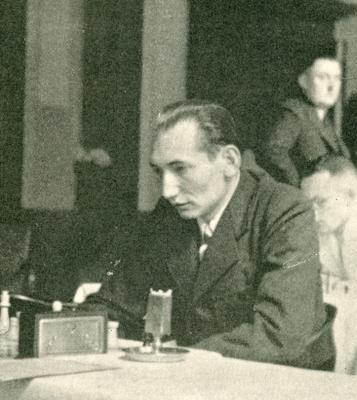
Erich Eliskases
A justly celebrated work of fiction, ‘Last Round’ by Kester Svendsen (1912-68) was included in, for instance, Reinfeld’s The Treasury of Chess Lore and Chernev’s The Chess Companion. It originally appeared on pages 121-126 of Chess World, 1 June 1947, and page 142 of that issue described Svendsen as ‘a professor at the University of Oklahoma’ and identified the game featured in the story as Charousek v Wollner, Kaschau, 1893.
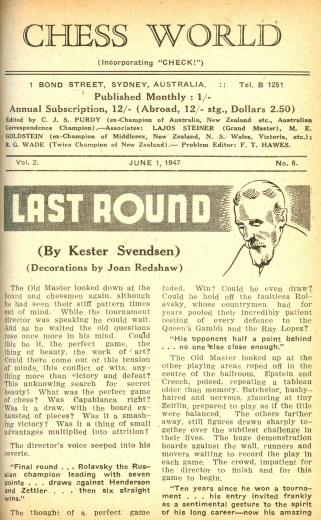
The game received international attention in 1897, being published on page 145 of the May Deutsche Schachzeitung and page 317 of the August BCM. The latter mentioned as its source Magyar Sakkujság, and we should like to know whether that Hungarian periodical supplied further details. The venue is sometimes mistakenly given as Vienna.
Page 45 of volume three of Magyar Sakktörténet (Budapest, 1989) stated that the game was played on 9 April 1893, and the book had several other games between Charousek and Wollner. These were also included in Chess Comet Charousek by V.A. Charuchin (Unterhaching, 1997). From elsewhere in the Magyar Sakktörténet series we know that Wollner’s forename was Jakob, and any biographical information about him will be welcome. [Correction in February 2009: Fabrizio Zavatarelli (Milan, Italy) pointed out to us that the Hungarian series gave the forename as Jakab, not Jakob.]
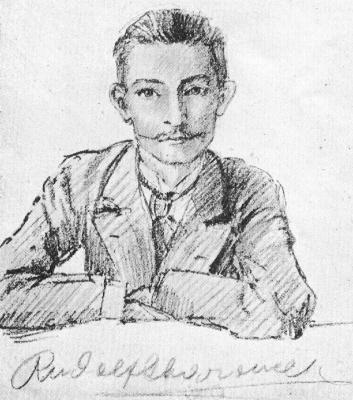
Rudolf Charousek (sketch from life
by Mrs G.A. Anderson, Chess Pie, 1922, page 67)
The Christmas 1969 issue of CHESS had a quiz which claimed (on pages 116 and 125) that D. Janowsky ‘was so annoyed at reaching a losing position against Sir George Thomas’ that he ‘did not arrive for resumption of play, and the tournament director upon opening the envelope merely found the word “abandonnent”.’ No occasion was specified or source given, but it seems that Janowsky’s only loss to Sir George Thomas was at Marienbad, 1925 – an 88-move game given on pages 96-97 of the tournament book.
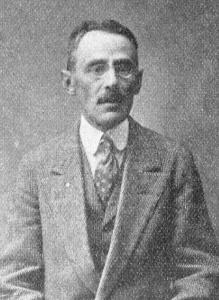
Dawid Janowsky
In an article entitled ‘Unconventional Surrender’ on page 55 of
the February 1950 Chess Review Hans Kmoch and Fred
Reinfeld stated that such an incident occurred in the game between
Müller and Yates at Kecskemét, 1927, and that White sealed ‘aufgegeben’.
See page 130 of Reinfeld’s The Treasury of Chess Lore
(New York, 1951). Kmoch was a participant in the tournament.
From page 42 of Carl Schlechter! Life and Times of the Austrian Chess Wizard by Warren Goldman (Yorklyn, 1994):
‘The press of his Handbuch duties nevertheless prevented him from accepting invitations to play in the two great events of that year – St Petersburg (Russia) and Mannheim (Germany).’
Reuben Fine on page 240 of Chess Review, August-September 1943:
‘The only active top-notcher missing [from St Petersburg, 1914] was Schlechter (the story is that he meant to play but absent-mindedly took the wrong train).’
From Christian Sánchez (Rosario, Argentina):
‘I have examined the July 1941 newspapers and found no news reports about Ilmar Raud (such as police incidents) but I can provide the obituaries and funeral notices from La Prensa and La Nación of 14 July 1941. It is interesting to note the omission of awkward details and the support shown, after his demise, by chess and non-chess clubs.
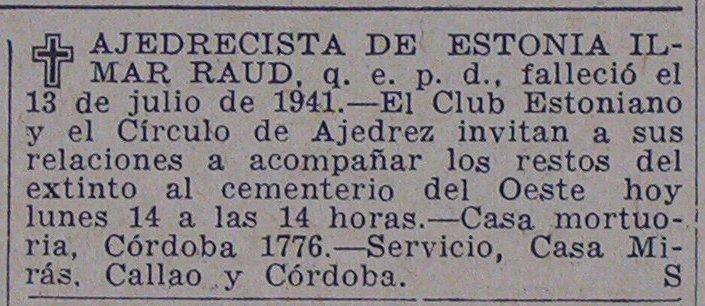
La Nación, 14 July 1941
However, decades later some contemporaries felt able to speak openly. In an interview on pages 186-189 of Ajedrez de Estilo, Milcíades Lachaga stated:
“Hubo maestros extranjeros que prácticamente murieron de hambre como por ejemplo: Ilmar Raud de Estonia. El vivía miserablemente y un día a causa del frío, cayó en la calle y lo llevaron a una comisaría donde no le brindaron atención médica porque creían que estaba sólo borracho. Falleció de pulmonía.”’
Our English translation: ‘There were foreign masters who practically died of hunger, such as Ilmar Raud of Estonia. He was living a wretched existence and one day, on account of the cold weather, he fell over in the street and was taken to a police station, where he received no medical attention because they thought that he was merely drunk. He died of pneumonia.’
Gordon Gribble (Gettysburg, PA, USA) and Russell Miller (Chelan, WA, USA) draw attention to a memorial tribute to Kester Svendsen in the archives of the University of Oregon. It includes the following passage:
‘He did not describe his work in poetic terms. To him, his successes in Machiavellian manipulations of the department budget, in persuading good men to come to Oregon, in vigorously pushing through promotion and tenure for younger members of the department as soon as they became eligible for consideration, in wangling salary increases for everybody who deserved one – his skill in these maneuvers, he said, was the result of years of chess competition in the stiffest circles. An ability to think many moves ahead, to anticipate any possible countermove, and to carry in his head a complete diagram of the academic game stood him in good stead.
Every aspect of the game was computerized in his mind and stored in his phenomenal memory. Not for nothing had he once memorized the 2,853 lines of the first two books of Paradise Lost, just to show that he could do it.’

Selected Letters of Sergei Prokofiev translated and edited by Harlow Robinson (Boston, 1998) has a few brief references to chess masters. For example, page 15 quotes an item of correspondence which he wrote to Eleonora Damskaya from Newcastle, England on 12 June 1914. The second paragraph reads:
‘A propos, did you get a chance to see Capablanchik in the issue of Novyi Svet of 04/01? Isn’t he sweet?’
Does any reader have access to that issue? An editor’s footnote on the same page stated: ‘Capablanchik is an endearing Russian diminutive for Capablanca. Prokofiev uses it to show his warm feelings for the famous chess player.’ On the previous page a footnote incorrectly described the Cuban as ‘the world champion at the time’ (of the St Petersburg, 1914 tournament).
In a letter to the same correspondent, written in Ettal, Germany on 5 June 1923, Prokofiev remarked:
‘Alekhin is reaping international laurels on 64 different fields [sic] of competition, pursues only gray-haired ladies, and is planning to play a chess match with Capablanca for the world championship; Capablanca himself is in Havana, where he is fussing over a newborn child.’
Avital Pilpel (Haifa, Israel) refers to page 177 of Secrets of Grandmaster Chess by John Nunn (London, 1997), which states that at the Malta Olympiad in 1980 Tony Miles sealed ‘Resigns’ in his game against Lajos Portisch.
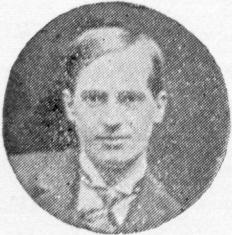
Harry Nelson Pillsbury
Scott D. Young (Crawfordville, FL, USA) asks:
‘Who was the first to print the cause of Pillsbury’s demise?’
In C.N. 342 a correspondent, W.D. Rubinstein, quoted from page 42 of A Catalog of USA Chess Personalia by Jeremy Gaige (Worcester, 1980) the following comments regarding Pillsbury:
‘... it should be noted that his death certificate said he died of “general paresis”, i.e. syphilis. I have found many other indications in Philadelphia that this was in fact the case, e.g. the scrapbooks of Walter Penn Shipley contained a typewritten obituary (presumably by Shipley himself) that said Pillsbury died of “general paresis”.’
In that same C.N. item W.D. Rubinstein quoted from a letter to him from Jeremy Gaige dated 27 October 1982:
‘I have no documentation on where he contracted syphilis. Interestingly, Friends Asylum still has the day-by-day log and medical records of Pillsbury, but strictly forbids any inspection of same. Tantalizingly, a hospital official read me a few innocuous sentences from the records, but that is all. I did have two indirect accounts that he did in fact contract the disease in St Petersburg (from Bill Ruth 1886-1975 and J. Edmund Peckover 1896-1982). Peckover said he was told that version by A.B. Hodges, who said he was told that by Pillsbury himself.’
When the word ‘syphilis’ was first used in connection with Pillsbury’s death we do not know. ‘Paresis’ appeared in his obituary on page 290 of the July 1906 BCM, but the context should be noted:
‘On his return to Philadelphia he was examined by the best medical experts, one of whom, Dr Charles K. Mills, a noted specialist of great repute in the United States, expressed the opinion that Mr Pillsbury’s affliction was not caused by his chessplaying, and this testimony was supported by Dr Chase, also an expert on the subject of paresis. The probability is that the real cause of the breakdown was irregularity in time of eating and sleeping, and the neglect of out-door exercise, together with excessive smoking.’
Readers are invited to submit further citations.
1 d4 d5 2 Nf3 Nf6 3 e3 e6 4 c4 c5 5 Nc3 Nc6 6 a3 cxd4 7 exd4 Be7 8 Bd3 dxc4 9 Bxc4 a6 10 O-O Qc7 11 Re1 O-O 12 d5 Rd8 13 Bg5 Nb4 14 Qb3 Nbxd5
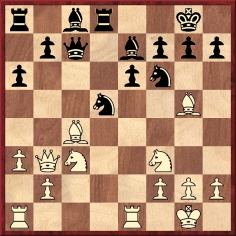
15 Bxd5 Nxd5 16 Nxd5 Rxd5 17 Bxe7 Qxe7 18 Qxd5 Resigns.
On page 6 of Samuel Reshevsky by Stephen W. Gordon (Jefferson, 1997) this game (‘Reshevsky – N.N.’) was described as played in a simultaneous display in Paris on 17 May 1920. No source was given, but we note that on pages 141-142 of Ajedrología by Julio Ganzo (Madrid, 1971) Black was named as ‘Mauvaisse’.
Francis E.W. Ogle (Medwood, NJ, USA) reports that Allen Kaufman had a letter printed in the New York Times of 13 April 2007 which related a story he had been told by Olga Capablanca:
‘Capa was playing in a tournament in Russia in the 1930s. Some of the best in the world’s best [sic] were competing, including Soviets and foreigners. A famous personality arrived to watch the event: Stalin.
The dictator approached Capablanca and asked, “How do you like my tournament?”
Capa replied, “It’s terrible; your players are cheating.”
Stalin: “What do you mean?”
Capa: “When they play against each other, the Soviets make quick draws and they get to rest. When they play against me, they fight on and on just to make me tired.”
The cheating stopped immediately.’
Our correspondent notes that Capablanca’s complaint to Stalin was referred to on page 212 of A Chess Omnibus. Olga Capablanca mentioned such an incident to us a number of times (in writing and orally), and below we reproduce verbatim what she wrote to us on 26 July 1989:
‘It is little known, I believe, that Stalin came to see Capablanca play, hiding behind a drapery. This happened in Moscow in 1936. Capa had mentioned it to me en passant, so I am a bit hazy about the details, such as who had accompanied Stalin – seems to me it was Krylenko. However, the gist of this encounter remains quite clear in my mind.
Capa said to Stalin: “Your Soviet players are cheating, losing the games on purpose to my rival, Botvinnik, in order to increase his points on the score.”
According to Capa, Stalin took it good-naturedly. He smiled and promised to take care of the situation.
He did.
From then on the cheating had stopped and Capablanca had won the tournament all by himself. This was an important conquest, proving to the world that Capablanca returned to his own great form.
As he told it to me Capa added: “I had promised you to be again the best chessplayer in the world. So I have done it for you.”’
Below is a photograph of Olga Capablanca with Mikhail Botvinnik which she sent us in the 1980s:
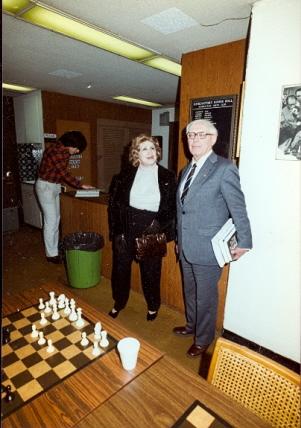
Readers are invited to tackle the problem below, which will be discussed in a future item:
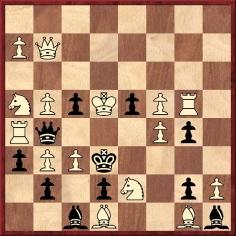
Mate in three.
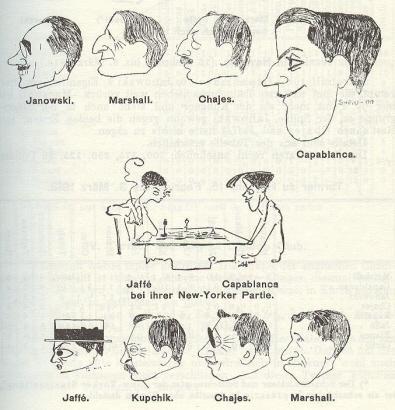
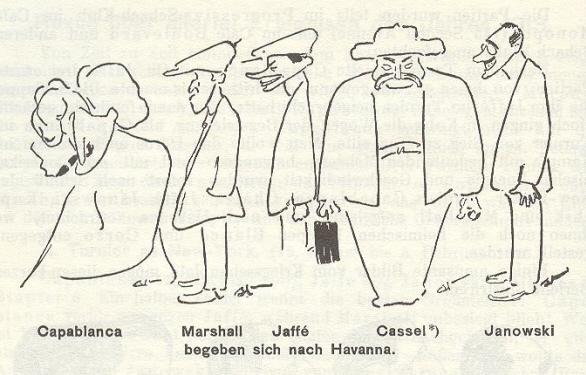
These caricatures were published on pages 3-4 of the January-February 1914 Wiener Schachzeitung. How many cases of misidentification are there?
Kester Svendsen is another chess figure who wrote on other subjects too. For example, our collection includes a copy of his 1956 volume Milton and Science, inscribed to Walter Stanley Campbell:
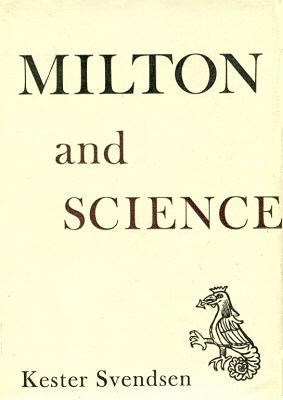
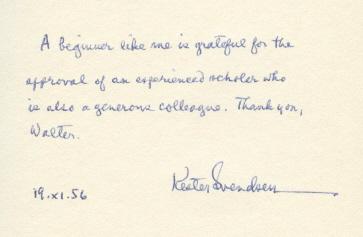
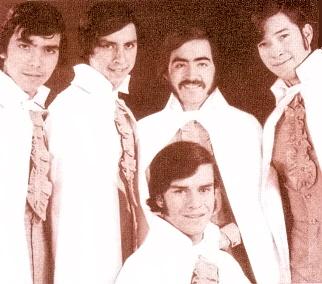
What is the connection with chess?
C.N. 3503 reproduced this engraving:
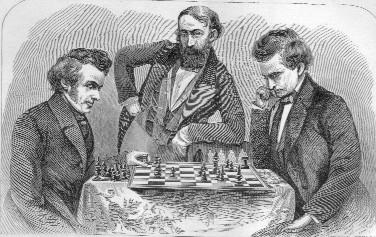
It was published in Brevity and Brilliancy in Chess by M.J. Hazeltine (New York, 1866), and our earlier item quoted from the author’s Introduction (pages x-xi):
‘The engraving forming our frontispiece has a genuine historical interest in the records of American chess. It illustrates the first really well-appointed passage at arms in Caissa’s lists, by an American challenger against a champion of name from the old world. And the likenesses, thanks to the painstaking skill of an accomplished artist, are admirably preserved, pleasing reminders of so memorable an epoch. J.H. Turner, Esq. against Charles H. Stanley, Esq., with the renowned Herr J. Löwenthal honoring the contest with his presence. The match was fought at Washington some 20 years since, Mr Stanley winning, but not without receiving some sturdy dints in return. In the particular position given, Mr Stanley is just lifting a rook to execute the initial coup of an announced mate in three moves. As may be supposed, he wears his “very happiest expression”.’
Rod Edwards (Victoria, BC, Canada) now writes:
‘Hazeltine’s book says that the Stanley v Turner match in Washington took place “some 20 years since”, whereas it was played in 1850. (Stanley’s famous match with Rousseau was in 1845.)
D.W. Fiske’s book on New York, 1857 has, on pages 389-396, a section by J. Löwenthal about his visit to America which clearly suggests that he was not present at the Stanley v Turner match. He describes his first introduction to Stanley in New York, not long after his arrival in the States, and says that they played chess that evening at Stanley’s house. He then adds (on page 391):
“It was about this time that Mr Stanley left for Washington, to play his match with Mr Turner; and when he returned victorious, he introduced me to the leading members of the New York Chess Circle ...”
Did the engraver of Hazeltine’s frontispiece use artistic license in putting Löwenthal in the picture? Or were any of the persons depicted, or even the event itself, misidentified by Hazeltine?’
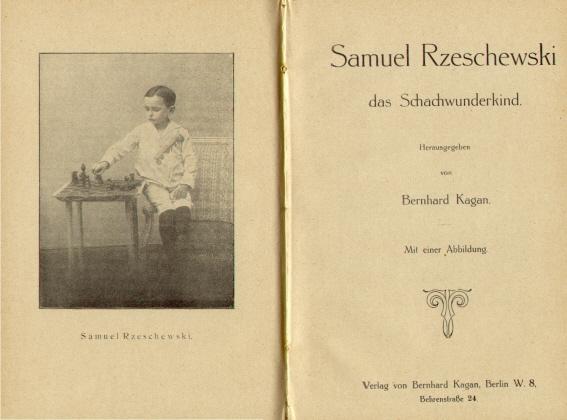
C.N. 4949 mentioned that the ‘Reshevsky v Mauvaisse’ miniature was published, without identification of Black, on page 6 of Stephen W. Gordon’s book Samuel Reshevsky (given as from a simultaneous exhibition in Paris on 17 May 1920). However, Marek Soszynski (Birmingham, England) points out that the same game-score also appeared on the previous page of the book, where it was labelled as between Reshevsky and Guhre in a simultaneous display in Berlin on 14 January 1920.
Our correspondent is collecting unpublished Reshevsky games and has yet to find, inter alia, three of his draws in the US Championship in New York, 1960-61, against R. Byrne, Benko and Bisguier.
From an unattributed article entitled ‘Chess’ on pages 464-469 of
the Rhode-Island Literary Repository, December 1814: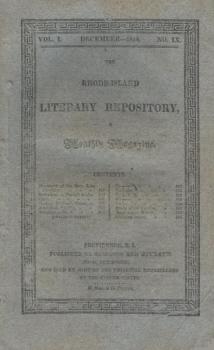
‘A game of chess is also a tolerably correct representation of two armies at war. The object of each party in both cases is the same, the destruction of the other. Or, at least, its defeat, which can never be effected without partial, and often proves nearly as bad as total, destruction. The methods pursued to obtain this object are also very much alike, differing only with the character of different performers. That activity, regularity and proper disposition of forces, which are indispensably necessary in the one are also the life and soul of the other. And indolence, confusion and disorder are equally injurious in both. As in war, offensive measures are almost invariably more profitable than defensive; so in chess, he who extends the sphere of operations as far from home as possible is generally successful, while he who suffers his own territories to be made the theatre of action is usually soon defeated. This game affords ample room for all those surprises, ambuscades and stratagems which are practised with such advantage by many generals. Here too may frequently be seen those desperate and destructive battles which sometimes take place between despair on the one hand and grief and rage on the other. It is also equally true in warfare and in chess that those attacks which are commenced without sufficient preparation are usually ineffectual, productive of injury rather than profit; and that those which are divided, partial and consequently feeble tend only to weaken the party who makes them, and strengthen the opposite. But the assaults which are made with full and united strength seldom fail of great execution.
As the just fame of the warriour is founded not in the destruction but in the saving of the human kind – so that of the chessplayer consists not so much in capturing the forces of his adversary as in effecting his own purpose with as little loss as possible.
Hansing and his army no doubt improved themselves in the art of war by the exercise of chess; for, in practising it, may be displayed the calmness, the contempt of fame, the discretion and the perseverance of a Fabius; the folly, the rashness and the impetuosity of a Minucius; the humanity, the amiability and the magnanimity of a Henry fourth; or the haughtiness, the obstinacy, the heroism and the foolhardiness of Sweden’s twelfth Charles.’
The practice of passing in simultaneous exhibitions was discussed on page 232 of the April 1964 CHESS. A reader, H.H. Watts of Southport, wrote:
‘Just prior to the First World War I played against Kostić in Manchester. After about 12 moves he obviously did not like his position because, from then on, after I had made my move he would look at it and pass on without moving but made his move at once on his next round. Consequently only about 25 moves were made, and he announced that it was a draw, as not enough had been done.
Boris Kostić
Then just prior to the Second World War I had the other experience against Alekhine in Liverpool. I was one of the last three still playing, with a pawn up and, as he told me afterwards, a winning position. He ran round these remaining three, insisting on a move each time he appeared, and I duly blundered and lost.’
In the mid-June 1964 issue of CHESS (page 306) C.W. Warburton of Warrington wrote:
‘... in the same situation against Sir G. Thomas in 1936 I reacted rather differently. I indicated that I was not ready and he could pass on, but he would not and stood fidgeting until I was ready to move, for I had determined I would not be rushed. After all I had attended to play a game of chess not skittles. In contrast, Capablanca was always prepared to move on to the next board if a player were not ready.’
The photograph in C.N. 4954 appeared on the front cover of a CD comprising 12 songs by the Chilean group ‘Capablanca’.

Can readers quote any unexpected relationships between chess figures? For example, on page 110 of the March 1933 BCM W.H. Watts noted that Jacob Schumer was the nephew of Julius Perlis.
Addition on 30 May 2019: As pointed out by a correspondent in C.N. 11334, Watts wrote, correctly, that Perlis was Schumer’s nephew.
A number of items about chess poetry are given in the Factfinder, and here we mention the work of James Russell Lowell. Page 220 of David Lawson’s biography of Paul Morphy The Pride and Sorrow of Chess (New York, 1976) noted that he ‘composed a poem of some one hundred lines’ for a ceremony in honour of Morphy in 1859. On page 93 of Grandmasters of Chess (Philadelphia and New York, 1973) Harold Schonberg quoted eight lines from what ‘could easily lay claim to being the worst poem in the English language’.
Rival claims are welcome.
Regarding the caption to the Meran, 1924 photograph in C.N. 4669, Luca D’Ambrosio (Bolzano, Italy) now considers that the person identified in Het Schaakleven as ‘Grim’ was probably Walter Grimm. There is a reference to ‘Grimm Walter, Referendar, Augsburg’ in the Kurzeitung und Fremdenliste Meran, 9 February 1924, page 4.
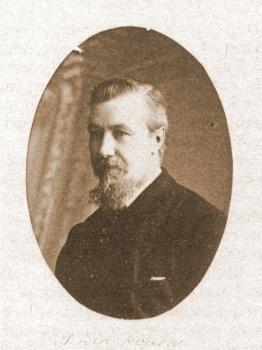
Joseph Henry Blackburne
The following paragraph appeared on page 248 of Lasker’s Chess Magazine, April 1905:
‘The Cheltenham Chronicle is authority for the remark that once upon a time Blackburne was playing a simultaneous series in one of the English chess clubs and upon his opponent replying to his P-K4 with P-K3 he tried to be facetious and said, “Ha, I resign”. The player promptly replied, “Thank you, Mr Blackburne, I accept. Mr Secretary, will you kindly score a win for me.” And the game was so scored.’
We recall that an earlier version of the yarn was different. From page 232 of the May 1891 BCM, in an article on Purssells, London (‘one of the greatest chess rooms in the world’):
‘Blackburne was once playing here with a very irascible old gentleman, who was most particular in enforcing all rules of the game and, when in a certain humour, could not take a joke. It was his own first move, and he played P-K3. “Ah”, said Blackburne, “now I resign.” “All right”, said his touchy opponent, “that’s one game to me”, and nothing, as Blackburne knew, would alter that determination, so it was duly scored. This is the shortest game on record. Blackburne was beaten in one move.’
Regarding George Koltanowski’s column in the San Francisco Chronicle (C.N.s 4799 and 4841) we should like to obtain a copy of the very last one, i.e. in February 2000. Can any reader assist?
Michael Clapham (Ipswich, England) points out this passage in the obituary of Miron Hazeltine on page 81 of the April 1907 American Chess Bulletin:
‘Mr Hazeltine was the owner of a large and valuable chess library, which is now in the market. In addition to a large number of the standard works and magazines, the collection includes scrap books, cuttings from exchanges and a complete file of the Clipper during the 50 years he edited its chess column.’
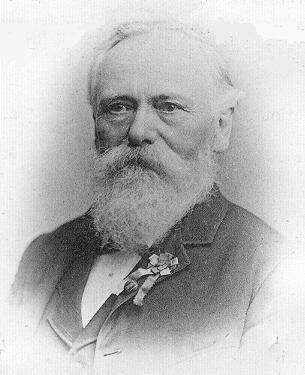
Miron Hazeltine
Information is sought on the subject of Jacob Bronowski and chess. A photograph of him opening the Hastings, 1961-62 event appeared on page 119 of the mid-January 1962 issue of CHESS:
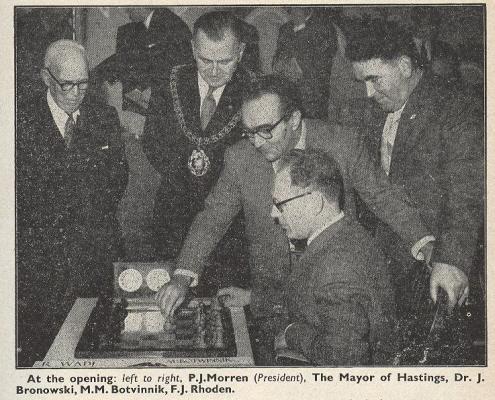
The next page reported:
‘Dr Bronowski, opening the congress, disclosed that he had played chess all his life “with pleasure and passion” and considered himself fortunate to have lived through the most tremendous half century in the development of the game. It was just 50 years since the public had suddenly become excited about chess: it began with the great San Sebastián tournament of 1911, when Capablanca first sprung to fame.
At the age of 14 Dr Bronowski learned chess and was taken by his father to a simultaneous exhibition by the then boy prodigy Reshevsky. When he entered the room, he was taken for Reshevsky and got a round of undeserved applause. In 1945 he had played for the Civil Service against a scratch team and found himself faced by a young boy in knickerbockers who had signed his score-sheet “Jonathan Penrose”.’
A future item will refer, in particular, to problems composed by Bronowski, such as the pair on page 399 of the September 1934 BCM.
| First column | << previous | Archives [33] | next >> | Current column |
Copyright 2007 Edward Winter. All rights reserved.